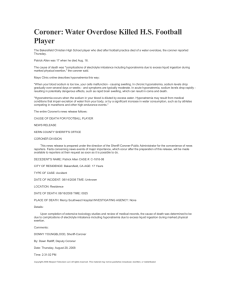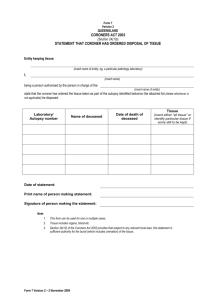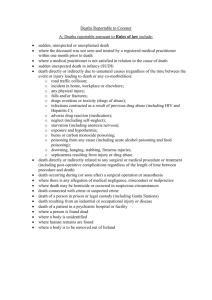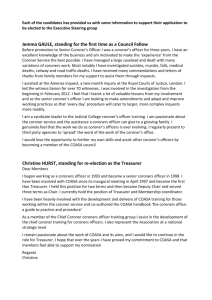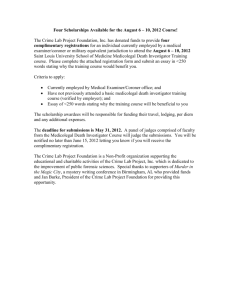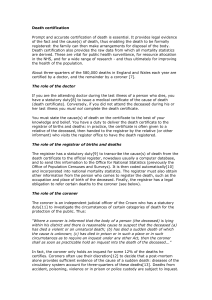Hospital Instructions - Riverside County Sheriff's Department
advertisement
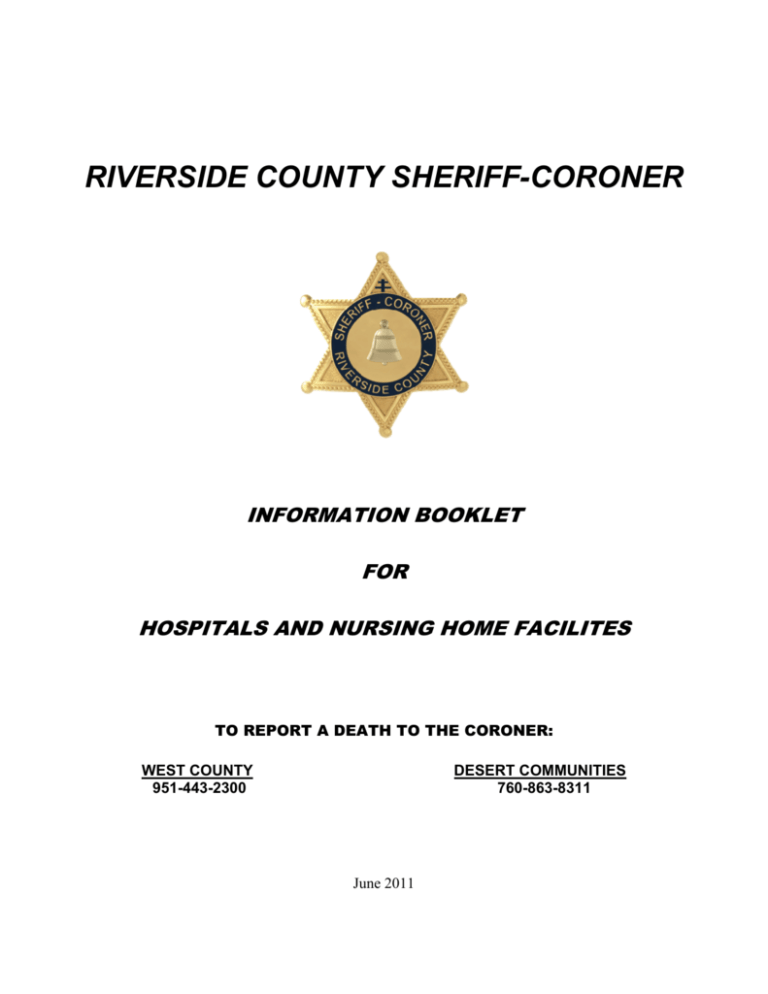
RIVERSIDE COUNTY SHERIFF-CORONER INFORMATION BOOKLET FOR HOSPITALS AND NURSING HOME FACILITES TO REPORT A DEATH TO THE CORONER: WEST COUNTY 951-443-2300 DESERT COMMUNITIES 760-863-8311 June 2011 INDEX Page I. INTRODUCTION 3 II. UNDERSTAND THE LAW 4 III. REPORTABLE DEATHS TO THE CORONER 5 IV. CASE HANDLING 8 V. MISCELLANEOUS INFORMATION 9 VI. RELEASE OF MEDICAL INFORMATION TO CORONER 10 VII. ORGAN AND TISSUE DONATION 11 2 I: INTRODUCTION This booklet is provided for the purpose of providing acute care and nursing facility personnel with general and specific information concerning the cases that come under the jurisdiction of the Riverside County Sheriff-Coroner. It is also available in a Power Point presentation. This information is intended to be utilized as a helpful guide for medical personnel. As laws and procedures change, this booklet will be updated on our website. Any questions concerning any information in this booklet can be directed to either office of the Coroner’s Bureau. Sheriff-Coroner Bureau – West 800 S. Redlands Avenue Perris, CA 92570 (951) 443-2300 (951) 443-2303 (FAX) Sheriff-Coroner Bureau - East 47-225 Oasis Street Indio, CA 92201 (760) 863-8311 (760) 863-7031 The Sheriff-Coroner website URL is www.riversidesheriff.org/coroner 3 II. UNDERSTAND THE LAW Once a patient is declared dead and falls under the jurisdiction of the Coroner as required by California Government and Health and Safety Codes, the following become applicable: The body may not be used for training or practice purposes. All medical apparatus shall remain in place. The body should not be removed from its location without the knowledge and consent of the Coroner. Clothing and personal property of the decedent, regardless of whether it is on the body or has been removed from the body, shall not be released to law enforcement personnel or next of kin without the knowledge and consent of the Coroner. No photographs shall be taken of the decedent. No fingerprints, handprints, or footprints shall be taken without the knowledge and consent of the Coroner. The death must be reported to the Coroner immediately. This may be done by hospital Staff or in some cases, the responsible law enforcement agency. FAILURE TO COMPLY WITH THE ABOVE REQUIREMENTS MAY COMPROMISE A CRIMINAL AND/OR MEDICOLEGAL INVESTIGATION OF DEATH. FAILURE TO COMPLY COULD ALSO RESULT IN LEGAL SANCTIONS. IT IS EXTREMELY IMPORTANT THAT ALL PERSONS INVOLVED IN THE HANDLING OF CORONER’S CASES COORDINATE THEIR ACTIONS AND COMMUNICATE THEIR NEEDS AND CONCERNS TO THE CORONER TO AVOID DUPLICATION OF EFFORT, AND AVOID DESTRUCTION, MISHANDLING, OR LOSS OF POTENTIAL EVIDENCE OR PERSONAL PROPERTY. 4 III. REPORTABLE DEATHS TO THE CORONER California Health and Safety Code Section 102850 and Government Code Section 27491 require that certain deaths must be reported to the Coroner and directs the Coroner to inquire into and determine the circumstances, cause and manner of the following deaths which are immediately reportable to the Coroner. A. Health and Safety Code Section 102850 A physician and surgeon, physician assistant, funeral director, or other person shall immediately notify the coroner when he or she has knowledge of a death that occurred or has charge of a body in which death occurred under any of the following circumstances: 1. Without medical attendance. 2. During the continued absence of the attending physician and surgeon. 3. Where the attending physician and surgeon or the physician assistant is unable to state the cause of death. 4. Where suicide is suspected. 5. Following an injury or an accident. 6. Under circumstances as to afford a reasonable ground to suspect that the death was caused by the criminal act of another. Any person who does not notify the coroner as required by this section is guilty of a misdemeanor. B. Government Code Section 27491 It shall be the duty of the Coroner to inquire into and determine the circumstances, cause and manner of: 1. All violent, sudden or unusual deaths. 2. Unattended deaths. 5 3. Deaths wherein the deceased has not been attended by a physician in the 20 days before death. 4. Death related to or following known or suspected self-induced or criminal abortion. 5. Known or suspected homicide, suicide, or accidental poisoning. 6. Deaths known, or suspected as resulting in whole or part from, or related to accident or injury, either old or recent. 7. Deaths due to drowning, fire, hanging, stabbing, cutting, exposure, starvation, acute alcoholism, drug addiction, strangulation and aspiration. 8. Where the suspected cause of death is Sudden Infant Death Syndrome (SIDS). 9. Death in whole or in part occasioned by criminal means. 10. Deaths associated with a known or alleged rape or crime against nature. 11. Deaths in prison or while under sentence. 12. Deaths known or suspected as due to a contagious disease and constituting a public hazard. 13. Deaths from occupational disease or occupational hazards. 14. Deaths of patients in state mental hospitals serving the mentally disabled and operated by the State Department of Mental Health. 15. Deaths of patients in state hospitals serving the developmentally disabled and operated by the State Department of Developmental Services. 16. Deaths under such circumstances as to afford a reasonable ground to suspect that the death was caused by the criminal act of another or any deaths reported by physicians or other persons having knowledge of death, for inquiry by the Coroner. 17. Any deaths reported by physicians or other persons having knowledge of death for inquiry by the Coroner. Any person who does not notify the coroner as required by this section is guilty of a misdemeanor. 6 C. Deaths Requiring An Inquiry/Decision Certain types of cases not listed in the State laws but which often pose problems or are difficult to evaluate, should be reported to the Coroner for a decision. These include, but are not limited to the following: Deaths of patients in the emergency room or within 24 hours of admission into the hospital. Deaths of patients who underwent surgery during this admission. Deaths occurring in operating rooms or when the patient has not regained consciousness after anesthesia. Deaths occurring during any therapeutic or diagnostic procedure or as a result (in whole or in part) of complications of these procedures. Deaths in which the patient is comatose on arrival and remains comatose throughout the hospital stay unless the cause of the coma has been definitively established as being due to a natural disease process. Deaths of unidentified persons will be accepted as a Coroner’s case. The Coroner will attempt to identify the decedent. All previous attempts to identify the patient by hospital staff, law enforcement or social service agencies should be well documented in the medical records. Deaths in which any type of injury is the cause or a contributing cause regardless of how distant or remote in time or place the injury may have occurred. This includes subdural hematomas, coma, paraplegia, quadriplegia and hip fractures or other fractures, regardless of the time interval between the occurrence of injury and death. 7 IV. CASE HANDLING In deaths known or suspected as coming under the jurisdiction of the Coroner, all diagnostic or therapeutic apparatus on or in the body at the time of death should not be disturbed or removed from the body without the consent of the Coroner. Tubes and intravenous lines may be cut and clamped to prevent drainage. Do not clean the body or clothing after death. Viewing of the body by family members before removal may be permissible provided the body is not cleaned or otherwise disturbed. Please consult with the deputy coroner prior to allowing anyone to view the body. Touching of the body is not permitted. Viewing and/or touching of the body in cases of infant deaths in the emergency room or any other death where there is potential for criminal investigation, is strictly prohibited until the deputy coroner arrives at the location. All clothing of the deceased should remain with the body. Clothing on homicide or suspected homicide victims shall not be disposed of, or destroyed. It shall be released to the Coroner, or with the Coroner’s consent, it may be released to the investigating law enforcement agency. The body should not be disturbed in any fashion, including photography, fingerprinting or evidence collection without consent of the Coroner. Casts, splints, bandages, etc. that are on a person at death, shall be left intact. Paramedic backboards may be removed. IV needles, tracheal tubes, airways, drainage tubes and any other resuscitative implements on the person at death shall remain intact on the body. Therapeutic paraphernalia will be returned to the hospital upon request. If possible, admitting blood (including blood bank specimen), urine and other specimens should be saved on all patients who are classified in critical condition if their death would result in Coroner jurisdiction. The placenta or the pathology report of the placenta should be submitted with the body in cases of stillbirth, fetal demise, and perinatal death. 8 If specimens have been sent for serologies, toxicology, viral or bacterial culture from the emergency room or medical unit, do not discard and do not cancel the order since the patient expired. It could help the Coroner determine cause of death. If tests cannot be conducted due to cost, save the specimens for the Coroner. ========================================================================= V. MISCELLANEOUS INFORMATION Family or next of kin should not be approached for permission for a hospital autopsy prior to clearance from the Coroner’s office. Family or next of kin should also never be told that the Coroner will be performing an autopsy. Autopsies are not performed on all Coroner cases. The Coroner shall have discretion to determine the extent of inquiry to be made into any deaths falling within the provisions of the law. If such inquiry determines that an attending physician of record has sufficient knowledge to reasonably state the cause of death occurring under natural circumstances, the Coroner may authorize the physician to sign or electronically attest the death certificate. In all other instances, the Coroner or his appointed deputy shall sign or electronically attest the death certificate. The decision as to whether a death is in fact a Coroner’s case rests with the Coroner. If it is determined, after appropriate evaluation, that the death is not a Coroner’s case, it then becomes the responsibility of the attending physician to sign or electronically attest the death certificate. According to California Health and Safety Code 102825, The physician and surgeon last in attendance, or in the case of a patient in a skilled nursing or intermediate care facility at the time of death, the physician and surgeon last in attendance or a licensed physician assistant under the supervision of the physician and surgeon last in attendance, on a deceased person shall state on the certificate of death the disease or condition directly leading to death, antecedent causes, other significant conditions contributing to death and any other medical and health section data as may be required on the certificate; he or she shall also specify the time in attendance, the time he or she last saw the deceased person alive, and the hour and day on which death occurred, except in deaths required to be investigated by the coroner. This is required by law to be done within 15 hours after death. A physician and surgeon may designate, one or more other physicians and surgeons who have access to the physician and surgeon's records, to act as agent for the physician and surgeon for purposes of the performance of his or her duties under this section, provided that any person so designated acts in consultation with the physician and surgeon. 9 VI. DISCLOSURE OF MEDICAL INFORMATION BY PROVIDERS Per California Civil Code - Section 56.10 (b)-(8) & 56.10 (c)-(6) (b) A provider of health care, a health care service plan, or a contractor shall disclose medical information if the disclosure is compelled by any of the following: (8) By a coroner, when requested in the course of an investigation by the coroner's office for the purpose of identifying the decedent or locating next of kin, or when investigating deaths that may involve public health concerns, organ or tissue donation, child abuse, elder abuse, suicides, poisonings, accidents, sudden infant deaths, suspicious deaths, unknown deaths, or criminal deaths, or when otherwise authorized by the decedent's representative. Medical information requested by the coroner under this paragraph shall be limited to information regarding the patient who is the decedent and who is the subject of the investigation and shall be disclosed to the coroner without delay upon request. Per HIPAA exemption from Code of Federal Regulations - 45 CFR 164.512(b)(1) permits “covered entities” to disclose protected health information -without patient authorization- to the public health authority authorized by law to receive such information for the purpose of public health surveillance and investigations. SECTION 31. 146.82 (2) (a) 18. of the statutes is created to read: Following the death of a patient, to a coroner deputy coroner, medical examiner or medical examiner’s assistant, for the purpose of completing a medical certificate under s. 69.18 (2) or investigating a death under s. 979.10. The health care provider may release information by initiating contact with the office of the coroner or medical examiner without receiving a request for release of the information and shall release information upon receipt of an oral or written request for the information from the coroner, deputy coroner, medical examiner or medical examiner’s assistant. The recipient of any information under this subdivision shall keep the information confidential except as necessary to comply with s. 69.18, 979.01 or 979.10. 10 VII. ORGAN AND TISSUE DONATION The Coroner is ultimately responsible for determining the cause and manner of death and a decision to authorize organ or tissue harvesting rests with the Coroner. The Riverside County Sheriff-Coroner is extremely supportive of organ and tissue donation and approval is given by the Coroner in a high percentage of requests. Not only is it important to report a death to the Coroner for reasons discussed earlier, it is extremely important for the successful accomplishment of effective organ and tissue recovery procedures. Depending on circumstances surrounding a death, it can take the Coroner several hours to approve a request. Removal of tissue from Coroner’s cases for scientific or transplant purposes must not be performed without prior approval of the Coroner, regardless of registered donor status or next of kin authorization. 11
